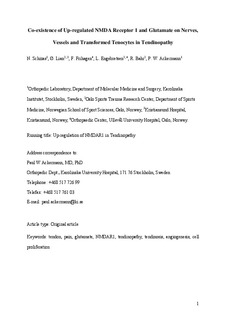| dc.contributor.author | Schizas, Nikos | |
| dc.contributor.author | Lian, Øystein | |
| dc.contributor.author | Frihagen, Frede | |
| dc.contributor.author | Engebretsen, Lars | |
| dc.contributor.author | Bahr, Roald | |
| dc.contributor.author | Ackermann, Paul W. | |
| dc.date.accessioned | 2010-04-30T08:34:32Z | |
| dc.date.available | 2010-04-30T08:34:32Z | |
| dc.date.issued | 2009-04-14 | |
| dc.identifier | Seksjon for idrettsmedisinske fag / Department of Sports Medicine | |
| dc.identifier.citation | Scandinavian Journal of Medicine & Science in Sports. 2010, 20(2), 208-215 | en_US |
| dc.identifier.issn | 0905-7188 | |
| dc.identifier.uri | http://hdl.handle.net/11250/170523 | |
| dc.description | I Brage finner du siste tekst-versjon av artikkelen, og den kan inneholde ubetydelige forskjeller fra forlagets pdf-versjon. Forlagets pdf-versjon finner du på www.wiley.com: http://www3.interscience.wiley.com/journal/122324403/abstract / In Brage you'll find the final text version of the article, and it may contain insignificant differences from the journal's pdf version. The definitive version is available at www.wiley.com: http://www3.interscience.wiley.com/journal/122324403/abstract | en_US |
| dc.description.abstract | Elevated levels of the neurotransmitter glutamate and the presence of its receptor, N-methyl-d-aspartate receptor type 1 (NMDAR1), have been established in patients with tendinopathy, i.e. chronic tendon pain and degeneration. However, whether NMDAR1 is up- or down-regulated in tendinopathy and co-localized with glutamate is still unexplored. We hypothesize that an alteration in tissue expression and in the coexistence of NMDAR1 and glutamate occurs in tendinopathy and might play a role in nociception and possibly also progression of tendon degeneration (tendinosis). We therefore examined the tissue distribution and levels of NMDAR1 and glutamate in biopsies from patients with patellar tendinopathy (n=10) and from controls (n=8). The biopsies were single- and double-stained immunohistochemically for glutamate and NMDAR1 and assessed subjectively and semi-quantitatively. The chronic painful tendons exhibited a significant elevation of NMDAR1 (ninefold), which was independent of the observed increase in glutamate (10-fold). This up-regulation of NMDAR1 and glutamate was found to be co-localized on nerve fibers as well as on morphologically altered tenocytes and blood vessels. None of the controls exhibited neuronal coexistence of glutamate and NMDAR1. The neuronal coexistence of glutamate and NMDAR1, observed in painful tendinosis but not in controls, suggests a regulatory role in intensified pain signalling. | en_US |
| dc.language.iso | eng | en_US |
| dc.publisher | Wiley | en_US |
| dc.subject | tendon | en_US |
| dc.subject | pain | en_US |
| dc.subject | glutamate | en_US |
| dc.subject | NMDAR1 | en_US |
| dc.subject | tendinopathy | en_US |
| dc.subject | tendinosis | en_US |
| dc.subject | angiogenesis | en_US |
| dc.subject | cell proliferation | en_US |
| dc.title | Coexistence of up-regulated NMDA receptor 1 and glutamate on nerves, vessels and transformed tenocytes in tendinopathy | en_US |
| dc.type | Journal article | en_US |
| dc.type | Peer reviewed | en_US |
| dc.subject.nsi | VDP::Social science: 200::Social science in sports: 330::Other subjects within physical education: 339 | en_US |
| dc.source.pagenumber | 208-215 | |
